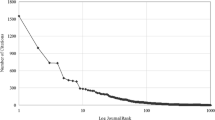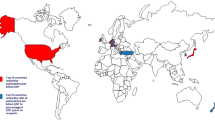Abstract
Our aim was to evaluate the impact of anatomy as a multidisciplinary area and to identify trends in research by anatomists over time. Data from three main sources were analyzed: SCImago Journal & Country Rank (SJR), using the number of total documents as indicator; MEDLINE (PubMed) database (1898 through October 2012), using the keyword “anatomy” in the “affiliation” field; and the Journal Citation Report (JCR), gathering impact factor and quartile data. The number of publications by anatomists increased between 1898 and 1941, followed by a reduction until 1961 and then by a marked rise to reach 36,686 between 2002 and 2012. After 1941, anatomists began to publish in journals from JCR categories other than “Anatomy & Morphology”, especially after 1962. Between 2007 and 2012, only 22.23 % of articles by anatomists in JCR-indexed journals were in the “Anatomy & Morphology” area and 77.77 % in journals from other categories; 58 % of their articles were in journals in the first and second quartiles. The contribution of anatomists to scientific knowledge is high quality and considerably greater than indicated by the SJR database. This input is especially relevant in the Neurosciences, Cell Biology, and Biology categories. In addition, more than two-thirds of manuscripts by anatomists appear in JCR-ranked publications, and more than half in the top two quartiles of the impact factor ranking. Our results show that the scientific production of anatomists has improved the quantity and quality of multi-disciplinary scientific activity in different knowledge areas.





Similar content being viewed by others
References
Bergstrom, C. T. (2007). Eigenfactor: Measuring the value and prestige of scholarly journals. College and Research Libraries News, 68, 314–316.
Blaxter, M. (1996). Criteria for evaluation of qualitative research. Medical Sociology News, 22, 68–71.
Boulton, M., & Fitzpatrick, R. (1994). Qualitative methods for assessing health care. Quality in Health Care, 3, 107–113.
Burrow, J. W. (2001). La crisis de la razón: El pensamiento europeo 1848–1914. Barcelona: Editorial Crítica.
Camí, J. (2001). Evaluación de la investigación biomédica. Medicina Clínica (Barcelona), 117, 510–513.
Castro Nogueira, L., Castro Nogueira, M. A., & Morales Navarro, J. (2005). Metodología de las ciencias sociales: Una introducción crítica. Madrid: Tecnos.
Garfield, E. (1999). Journal impact factor: A brief review. Canadian Medical Association Journal, 161, 979–980.
Garfield, E. (2006). The history and meaning of the journal impact factor. JAMA, 295, 90–93.
Garfield, E., & Welljams-Dorof, A. (1992). Citation data: their use as quantitative indicators for science and technology evaluation and policy-making. Science & Public Policy, 19, 321–327.
Harding, G., & Gantley, M. (1998). Qualitative methods: Beyond the cookbook. Family Practice, 15, 76–79.
Hirsch, J. E. (2005). An index to quantify an individual’s scientific research output. Proceedings of National Academy of Science of the United States of America, 102, 16569–16572.
Hoeffel, C. (1998). Journal impact factors. Allergy, 53, 1225.
Joseph, K. S. (2003). Quality of impact factors of general medical journals. British Medical Journal, 326, 283.
Karageorgopoulos, D. E., Lamnatou, V., Sardi, T. A., Gkegkes, I. D., & Falagas, M. E. (2011). Temporal trends in the impact factor of European versus USA biomedical journals. PLoS ONE, 6, e16300.
Lippi, G., Favaloro, E. J., & Guidi, G. C. (2009). The impact factor and journals in laboratory medicine. Clinical Laboratory, 55, 49–52.
Lucas Marín, A., & García Ruiz, P. (2002). Sociología de las Organizaciones. Madrid: McGraw-Hill.
Martín Gómez, T. (2008). Estudio del flujo de información sobre taxanos en el tratamiento sistémico del cáncer de mama. Doctoral Thesis: University of Salamanca.
Mays, N., & Pope, C. (1996). Rigour in qualitative research. In N. Mays & C. Pope (Eds.), Qualitative research in healthcare. London: BMJ Books.
Mays, N., & Pope, C. (2000). Qualitative research in health care: Assessing quality in qualitative research. British Medical Journal, 320, 50–52.
Moravcsik, M. J. (1989). ¿Cómo evaluar la ciencia y los científicos? Revista Española de Documentación Científica, 12, 313–325.
Neff, B. D., & Olden, J. D. (2010). Not so fast: Inflation in impact factors contributes to apparent improvements in journal quality. BioScience, 60, 455–459.
Parak, W. J. (2010). Characterizing the multidisciplinarity of nanoscience research. ACS Nano, 4, 4333–4334.
Price, D. J. S. (1965). Networks of scientific papers. Science, 149, 510–515.
Retzer, V., & Jurasinski, G. (2009). Towards objectivity in research evaluation using bibliometric indicators: A protocol for incorporating complexity. Basic and Applied Ecology, 10, 393–400.
Reuters, T. (2010). Journal Citation Reports. http://thompsonreuters.com/products_services/science/science_products/a-z/journal_citation_reports/. Accessed 16 Sept 2010.
Rogers, Y., Scaife, M., & Rizzo, A. (2005). Interdisciplinarity: An emergent or engineered process? In S. Derry, C. D. Schunn, & M. A. Gernsbacher (Eds.), Interdisciplinary collaboration: An emerging cognitive science (pp. 265–286). Mahwah: Lawrence Erlbaum Associates.
Rueda-Clausen Gómez, C. F.-, Villarroel Gutiérrez, C., & Clausen Pinzón, C. E. (2005). Indicadores bibliométricos: Origen, aplicación, contradicción y nuevas propuestas. MedUNAB, 8, 29–36.
Ruiz Limón, R. (2006). Historia y evolución del pensamiento científico. México: Ed. Eurler Ruiz.
Sancho, R. (1990). Indicadores bibliométricos utilizados en la evaluación de la ciencia y la tecnología: Revisión bibliográfica. Revista Española de Documentación Científica, 13, 842–865.
Stock, W. G. (2009). The inflation of impact factors of scientific journals. ChemPhysChem, 10, 2193–2196.
Urbizagástegui, R. (2005). The scientific productivity of authors: an application model of Lotka′s law by the generalized inverse power method. Información, Cultura y Sociedad, 12, 51–73.
Vinther, S., & Rosenberg, J. (2012). Impact factor trends for general medical journals: Non-english-language journals are lagging behind. Swiss Medical Weekly, 142, w13572.
Ziman, J. (1980). La fuerza del Conocimiento: La dimensión científica de la sociedad. Madrid: Ed. Alianza.
Acknowledgments
The authors wish to thank Beatriz Valero Aguilera for her assistance in the biostatistician analysis.
Author information
Authors and Affiliations
Corresponding author
Rights and permissions
About this article
Cite this article
Álvarez, P., Boulaiz, H., Vélez, C. et al. Qualitative and quantitative analyses of anatomists’ research: evaluation of multidisciplinarity and trends in scientific production. Scientometrics 98, 447–456 (2014). https://doi.org/10.1007/s11192-013-1006-8
Received:
Published:
Issue Date:
DOI: https://doi.org/10.1007/s11192-013-1006-8




